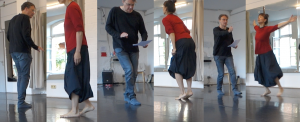The impact of words
This research focuses on the memorials of the Culture of Remembrance (Erinnerungskulture) in Germany and the impact on the body of the void of the abandoned spaces.
The memorials of mainly after the Second World War, where the original spaces are exhibit as the direct evidences of what had happened. Those places have distant with the history of my own country both geographically and the circumstances.
But in the same time, since I live in Berlin, it is the history that had happened very close to my own living space.
And since it had happened contemporary with the Japanese history of course, my research have been giving me another perspective on Japan in the WWII.
For this research I planed my creative process: that I visit those abandoned spaces, investigate the history and then search the movement and sound based on the experience that remains in my body. I thought it would be a rational process, but in reality it caused stagnant of movement.
After couple of month, I had to admit, that for me, in the process of creating sound, it is necessary to be alone as much as possible, but for this research theme, I need dialogue with the other(s’) body in the space.
In August, as I expanded my direction from making solos to collaborating, I looked at how the process could expand my perception of space and create and maintain the Atmosphere of trust (as Carlos and Fernando call it) necessary for improvisation.
I believe that in order to visualize the subjectivity of spatial perception through movement and sound, it is essential to utilize improvisation in the work.
Those questions have arisen in proceedings:
– At an improvisation in context of the void spaces connected to the German culture of remembrance, can words be an anchor for the improvisation?
– What is the necessary agreement or choreographic direction use words & text in the improvisation?
– What is the role of the words and text in the improvisation?

